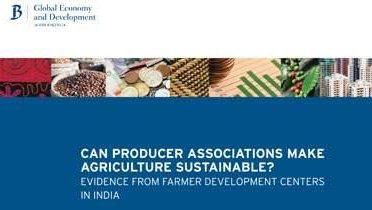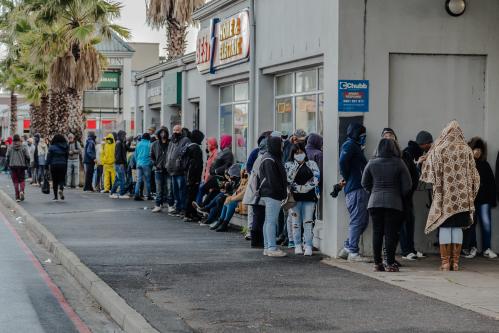INTRODUCTION
The problems in farming in developing countries are numerous and well-known: drought vulnerability, soil degeneration, a lack of financial instruments (credit and insurance), high transaction costs imposed by intermediaries, the inaccessibility of reliable inputs, and a lack of market opportunities. Over the past decade, agriculture in India has undergone what one state-level commission terms a period of “generalized rural distress,” producing high levels of rural unemployment, forced migration, and declines in per capita calorie consumption among the poor. Indian agriculture— characterized historically by much greater volatility than the general economy—has also been adversely affected in recent years by declining productivity, greater import competition, and rising prices for fertilizer, seed, and pesticides. Although the percent of agricultural employment in the labor force has been declining, most of that decline has been due to the loss of cultivators.
Adjustment costs in the Indian rural economy have fallen disproportionately on tenant farmers and rural day or “casual” laborers, and in particular, on female farmers. Women constitute only one-third of the Indian workforce, but three-quarters of these economically active women are engaged in agriculture (compared to 53 percent of men), as either workers in household farms owned or tenanted by their families, or as wage earners, and almost all of these agricultural workers are the informal sector. Moreover, Indian women face a range of disadvantages that are exacerbated by the pressures of rising input costs, cuts in agricultural subsidies and risks of weather shocks. First, they encounter steeper entry barriers than men in agriculture. Patriarchal inheritance codes restrict women’s property rights over agricultural land, particularly in North India (Agarwal 1994b; Dyson and Moore 1983). Barriers to access in land translate into barriers to accessing credit, since most formal sector loans require land titles. Female farmers also face other impediments such as cultural indifference, regulatory barriers, as well as higher bribe taxes from officials than their male counterparts (World Bank 2001). As a result, most women’s agricultural work is informal, done under conditions of high insecurity in relation to a lack of contract and benefits, and the availability of a large supply of surplus labor (Unni and Rani 2003).
Second, most government investments in agricultural- support programs—such as agricultural extension— have typically excluded women and have almost exclusively been targeted at men (Danida 2002; Raabe 2008). Third, the lack of collective-action mechanisms available to women in rural areas relative to men has limited female access and representation in local decision-making, and has contributed to the self-exclusion of women from a variety of participatory schemes and other community-based development programs that might mitigate the results of rural gender bias.
In recent years, several non-governmental organizations have attempted to address these issues and provide support to female farmers. “Membership-based organizations” have emerged to provide women with organizational resources that increase coordination, improve their capacity for management of collective goods (e.g., property, irrigation schemes), and support their participation in village affairs and local politics. In rural communities, producer associations have mobilized and organized female farmers, provided them with diverse services that include access to information and training, assistance in organizing inputs, marketing support, provision of credits, as well as in enhancing the bargaining power of farmers for securing better contracts and prices. The general basis for the proliferation of producer associations is the view that local farmers’ possess informational advantages regarding their own farming needs and placing them at the center of decision-making leads to greater efficiency, greater equity and lower transactions costs (Bank 2008; Chen et al. 2007).
Governments and multilateral development institutions have increasingly promoted producer associations. It is expected that collective action by farmers increases participation, improves agricultural productivity, establishes better connectivity with markets, and increases their bargaining power in securing inputs and selling outputs. In the long run, this contributes to both growth and poverty alleviation. Recent research however, demonstrates that this approach has its challenges. Evidence from Sub-Saharan Africa and South Asia suggests that local producer associations’ informational advantages may be nullified by problems ranging from local elite capture, exclusion of the poorest groups from decision-making, and the lack of information about the external environment and market conditions. These issues can prevent producer associations from translating their informational advantages into either agricultural productivity growth or poverty alleviation (Bernard and Spielman 2009).
Empirical assessments of the impact of producer associations are thus quite important. This evaluation focuses on a program in the Indian state of Gujarat that combines social empowerment with agricultural extension. The program, known as the “Women Farmers with Global Potential” (WFGP) initiative, focuses exclusively on rural women and draws on producer associations as the primary channel for delivering the intervention. The effort was coordinated by the Self-Employed Women’s Association (SEWA), a non-governmental organization that has acquired significant experience in the development of producer associations and other membership-based organizations for the rural poor in India.
We aim to evaluate the impact of the WFGP program at the individual level, considering both economic and non-economic outcomes. We examine results of SEWA membership on income, employment, empowerment, consumption, income, and assets of women in these communities. We draw on a survey of approximately 1,500 women in 42 villages in five rural districts in Gujarat conducted in 2010 over several months following the monsoon, divided between members of SEWA and non-members. Although villages were selected randomly for SEWA treatment, individual women were not. To control for problems of individual selection, then, we rely on propensity score matching on observables to ensure balance between SEWA members and non-members.
Our results illustrate that SEWA membership had some important effects: it raised awareness of available opportunities among its participants, and linked women to the financial sector, and to diversified employment opportunities, including non-farm work. SEWA members are less likely to work as unpaid workers, are more likely to have better knowledge of loan products available, more likely to have obtained those loans, and more likely to have superior information about market prices than non-members. SEWA women were also more likely to sell outside the established state-procurement system than non-members.
We also find considerable evidence of the heterogeneity of impact. SEWA membership benefitted the poorest women (as measured by residence in temporary or “kutcha” housing) as well as those who had faced previous income shocks. Relative to other women, these women experience higher farm and non-farm income, greater food consumption, improved household and farm productivity, more self-employment opportunities, a greater likelihood of opening a bank account, higher crop harvests, having access to adequate food for the family.
The remainder of this paper is organized as follows. The next section reviews agricultural extension programs in India, and describes SEWA’s intervention in detail. The section after that examines household impacts of the WFGP initiative. The final section discusses the prospects of scaling up the program in India as well as in other developing countries. The final section concludes and offers some implications for agricultural policy in India and globally.




